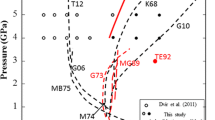Abstract
We have conducted H2O-undersaturated melting experiments on charges consisting of a layer of a sillimanite-bearing metapelite and a layer of garnet-bearing amphibolite, with the goal of studying how layered metamorphic rocks interact during anatexis. Experiments with the layered charges were performed at 10 kbar (1 GPa) at 900 °C (334 h), 925 °C (341 h), and 950 °C (50, 161, 332 h). Dehydration-melting of the amphibolite alone and of the pelite alone were studied at the same P-T conditions. When run alone at 900 °C, the pelite and the amphibolite yielded ca. 40 vol.% and 15 vol.% melt, respectively. Corresponding melt fractions at 950 °C were ca. 50 vol.% and 30 vol.%. When run side by side, melt abundance in the pelite is fairly uniform and ca. 20 vol.% higher than in the solo runs at all temperatures studied. In contrast, complex zoning patterns parallel to the interface develop in the amphibolite layer. Far from the interface the melt fraction is 5–10 vol.% lower than in the amphibolite-solo runs. Closer to the interface the melt fraction in the amphibolite layers are comparable to, or somewhat higher than, in the amphibolite-solo runs, and both clinopyroxene and plagioclase react-out and are replaced by orthopyroxene and quartz. Melt fraction closest to the interface reaches 65–70 vol.%, and the only crystalline phase present is garnet with hollow cores. The increase in melt fraction in the pelite layers of the layered runs is caused by transfer of Na from the amphibolite to the pelite, which forces biotite to be eliminated at lower temperature along the biotite-garnet reaction boundary. K is transferred from the pelite to the amphibolite, and the lower melt fraction in the distal end of the amphibolite layers is caused by faster diffusion of Na compared to K, which results in a net depletion of alkalies. Ca is transferred from the amphibolite to the pelite, and the resulting changes in CaO concentrations affect the stabilities of plagioclase, pyroxenes, garnet and quartz and cause the observed zoning in the amphibolite layer. Ca entering the pelite layer induces crystallization of large plagioclase neoblasts radiating from the interface into the pelite layer. These results show that diffusion of components between contiguous lithologies undergoing anatexis can cause profound changes in phase relations, melt fractions and restite compositions.
Similar content being viewed by others
Author information
Authors and Affiliations
Additional information
Received: 21 December 1994 / Accepted: 26 June 1995
Rights and permissions
About this article
Cite this article
Skjerlie, K., Douce, A. Anatexis of interlayered amphibolite and pelite at 10 kbar: effect of diffusion of major components on phase relations and melt fraction. Contrib Mineral Petrol 122, 62–78 (1995). https://doi.org/10.1007/s004100050113
Issue Date:
DOI: https://doi.org/10.1007/s004100050113




